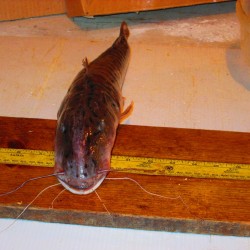Don’t let them go!
On a date?
Off to college?
Off to war?
No, I’m not talking about your children here. I’m talking about those cute little fishes that you or child just had to have for the aquarium. In this case, I’m talking more specifically about a Tiger Shovelnose Catfish–a harmless little catfish that comes from the Amazon that, when released in our warm waters, immediately becomes a non-native, invasive species.
I guess nobody realizes when they purchase a tiny little catfish for their aquarium that it might have a voracious appetite until it starts consuming all the other fish in their tank! In the wild, these fish can grow to reach five feet in length. So, in about a year, it will most likely have outgrown the tank, and then what?
Buy a bigger tank? Put it in your uncle’s pond? Or take it to a nearby river or lake and just set Wee Willy free? I’m betting on the last choice. Most folks don’t have room for a bigger tank, or an uncle with a pond, so off they go to the nearest body of water.
In a recent case here in Louisiana, someone in the general proximity of Melville, LA, along the Atchafalaya River at some point must have done so. There’s just no way that a Tiger Shovelnose Catfish (TSC) swam all the way from South America, across the Gulf of Mexico, and up the Atchafalaya to Melville. No. Way.
On July 3, Barbara Ducote was fishing the freshwater river with a worm on a hook when she landed a two-pound, 19-and-a-half-inch long TSC. I called her three times the day I received an email that had originated from the Department of Fisheries, so that I might get her fish tale, firsthand. She didn’t answer, and her voicemail box was full. I guess I wasn’t the only angler/writer who wanted the scoop.
I can just about imagine that she was serenely sitting there, fishing with a worm and a little bobber, hoping to catch some bream or perch for supper. When that bobber went down, she probably thought she had hooked herself a nice big catfish for the frying pan. Imagine her surprise when she came up with this beauty!
She did the right thing when she called the Department of Fisheries. The distinct markings helped the fish biologists figure out soon enough exactly what it was. Another journalist wrote that this fish is great table fare, but Barbara is going to have it mounted. Can’t say I blame her. I mean, how often do you catch a beauty like this? Besides, I don’t think I could eat something that came out of your aquarium, thank you very much.
I hope that Barbara’s catch is a once-in-a-lifetime catch. These fishes have such huge appetites that if enough of them are released, and they manage to find each other and mate, they would pose great competition for food among our native species of catfish. Oh, and they’re pretty smart, too, because they like shrimp and little crabs!
 The only good thing I can say about the TSC, is that they eat cichlids–another non-native, invasive from South America that is now abundant in our waters. I’m not sure, however, whether I’d rather have the cichlids or the TSC. How about neither?
The only good thing I can say about the TSC, is that they eat cichlids–another non-native, invasive from South America that is now abundant in our waters. I’m not sure, however, whether I’d rather have the cichlids or the TSC. How about neither?
So, folks, maybe it’s high time pet shop owners sell a fish with a warning about just how large it might become, even in captivity. And maybe everyone owning aquariums should become more responsible about dispatching unwanted fish rather than disposing of them in our natural waters.
What do you say?
BW
*Photos courtesy of LDWF





Yes!! Buyers of such species should be informed. It is a shame there is no way to “tag” each one sold and record the purchasers info. Set one free, let it be caught and buyer be fined.
Same with the little alligators that were sold at the fair. Our local lake that we received water from for several years had a couple in it that were enormous. During one severe drought, one was killed after attacking someone. Never did hear about the other one.
WHAT??? Baby alligators sold at a fair? Is that even legal in TX? It certainly isn’t legal here in La.
I don’t think it is any longer. But, they certainly had them when my two kids were in school.
That’s just crazy to me!
Scary! Having had aquariums growing up, I was under the understanding that fish would only grow to the size of the aquarium they were in…THIS information would have given me basement nightmares!!
Many of us were under that same impression, but this isn’t true for all species, obviously!
I have heard that when people released goldfish into the Ohio River the fish got really big. And I remember a fishpond at a neighbor’s house when I was growing up–I think it was her old well, filled in most of the way and then sealed at the bottom to make a pond. The goldfish in it were huge! I really, really hope that this was a one-time event, BW, and that there are no more of these fish lurking in southern waters.
I hope so, too, Susanna!
As a diver, I have watched the lionfish deplete the juvenile reef fish in many places. The devastation wrought by invasives should not be understated. Keep up the warnings!
It’s great hearing from you, Kay! Those lionfish are scary ones, too!
WHY are invasive species even legal to sell? Maybe that’s something our politicians could look into and agree that it should be illegal to sell.
If it is already the case, I apologize for my ignorance. It really “P”s me off!
That’s a really good question, Steffi! I think it happens on a very grand scale, when you include reptiles, lizards, and tropical species of other birds and animals.